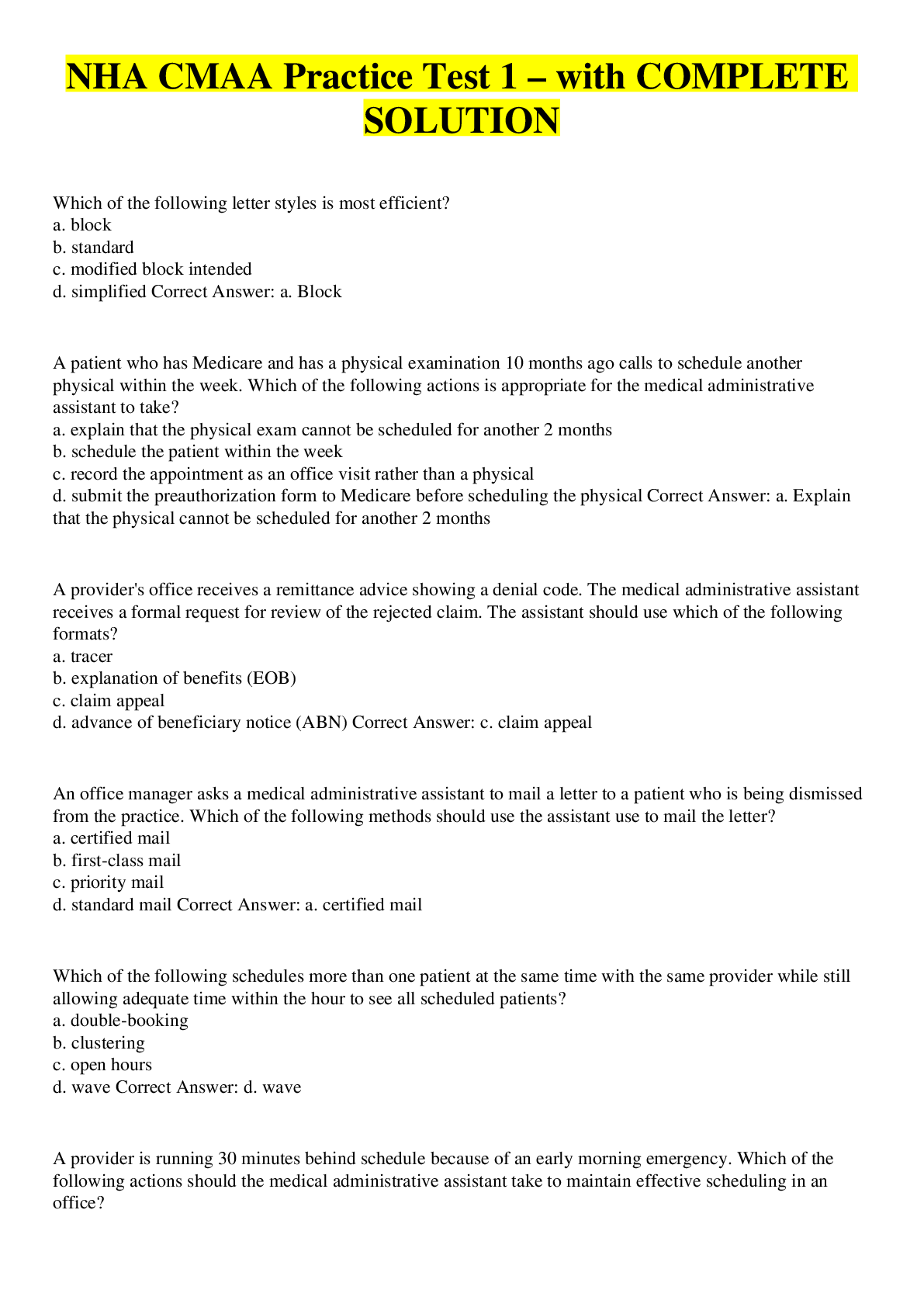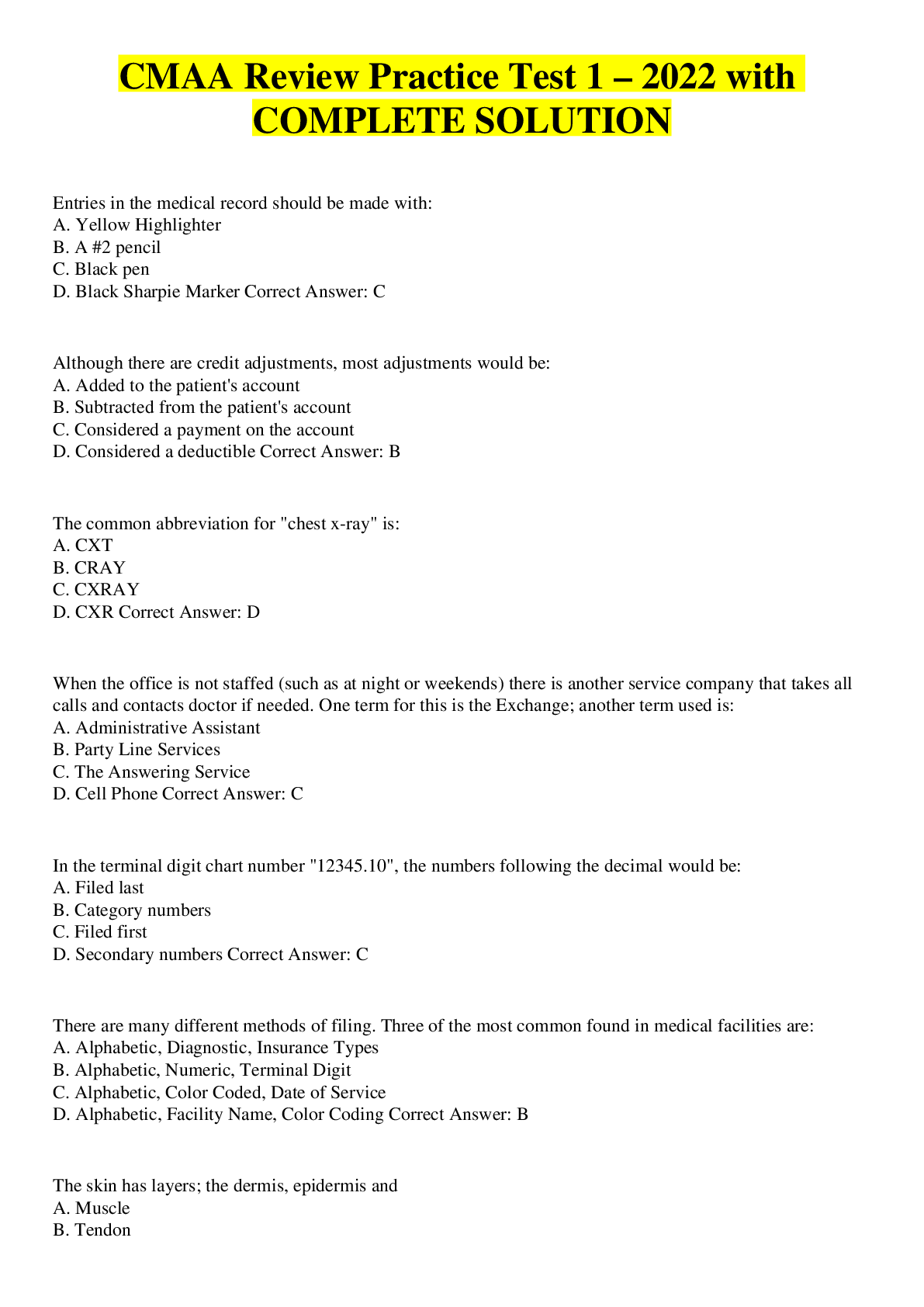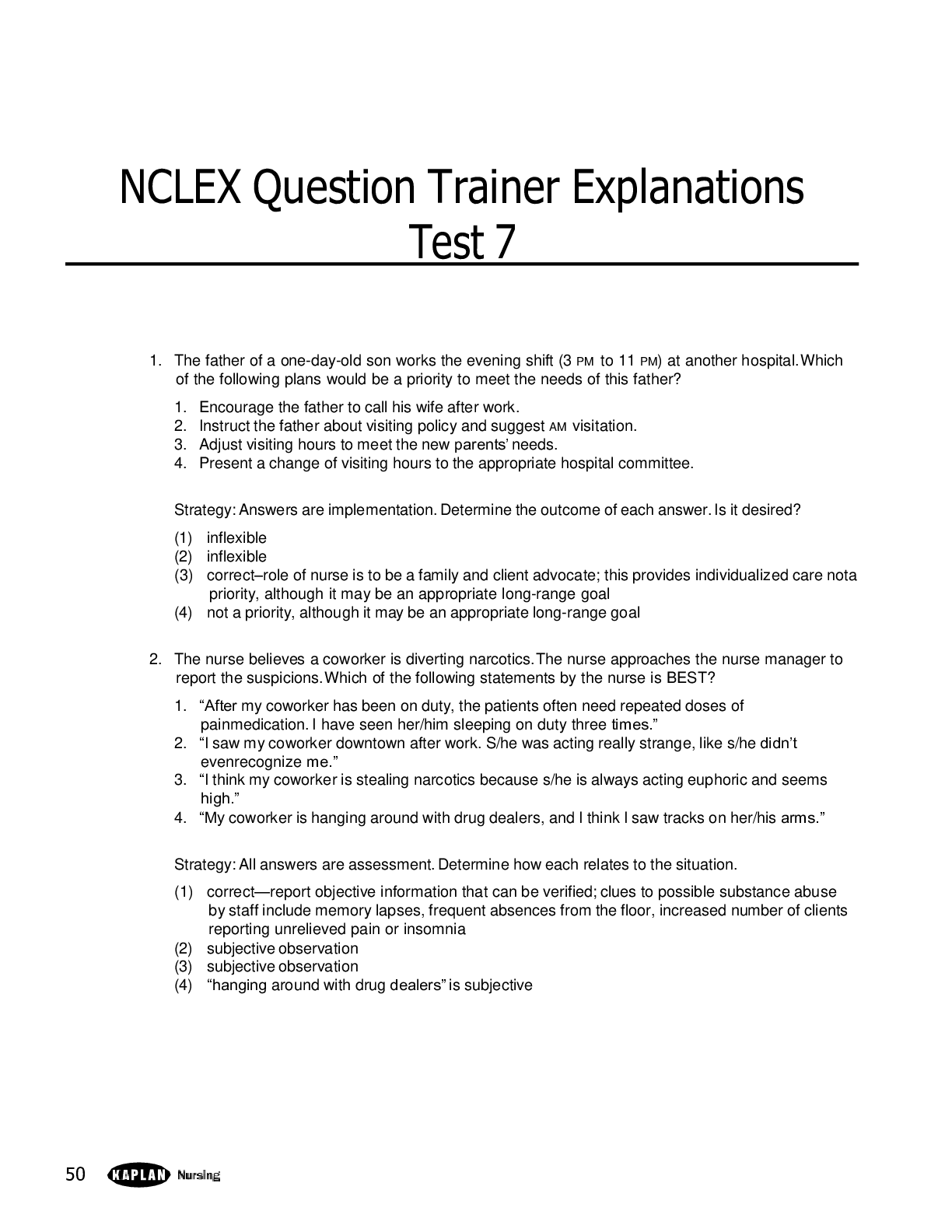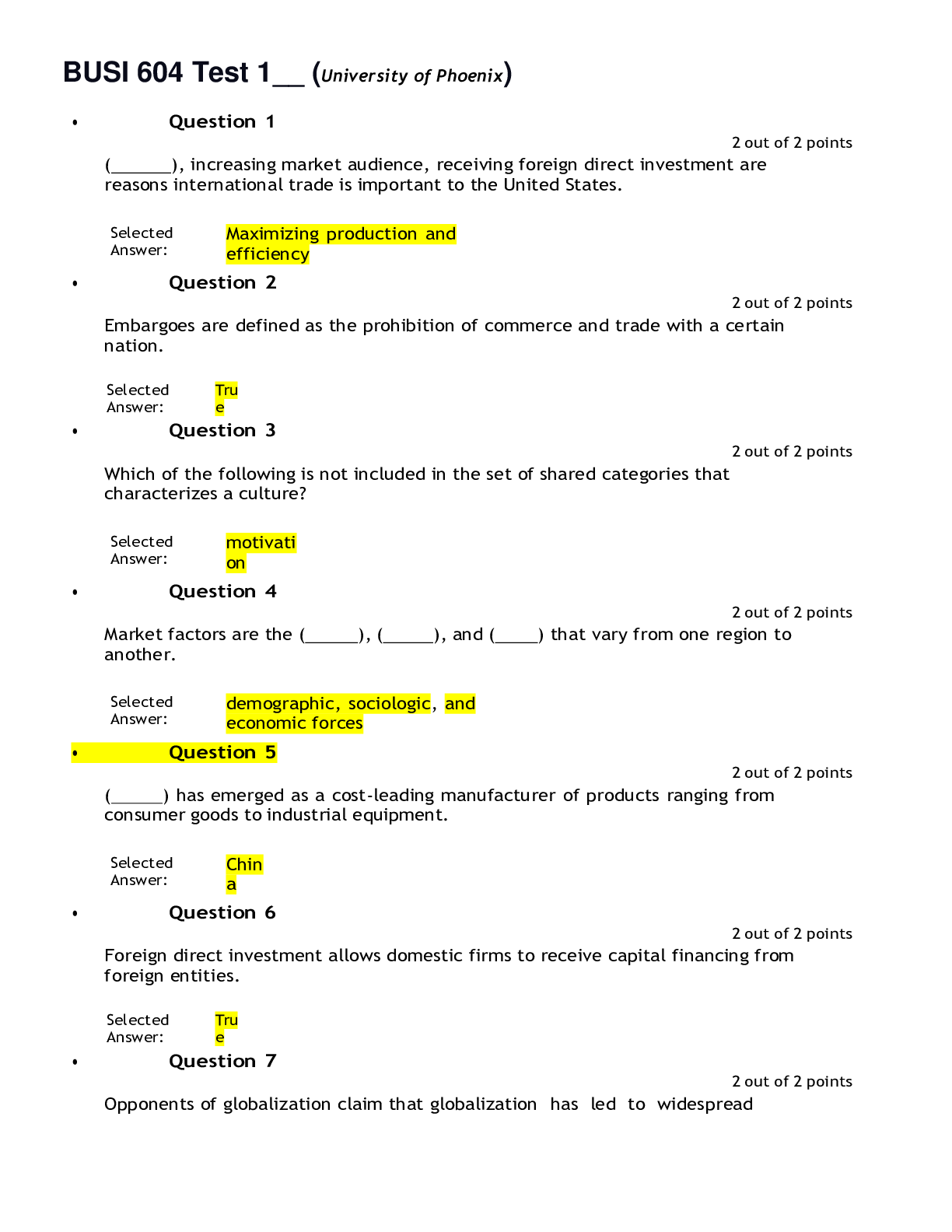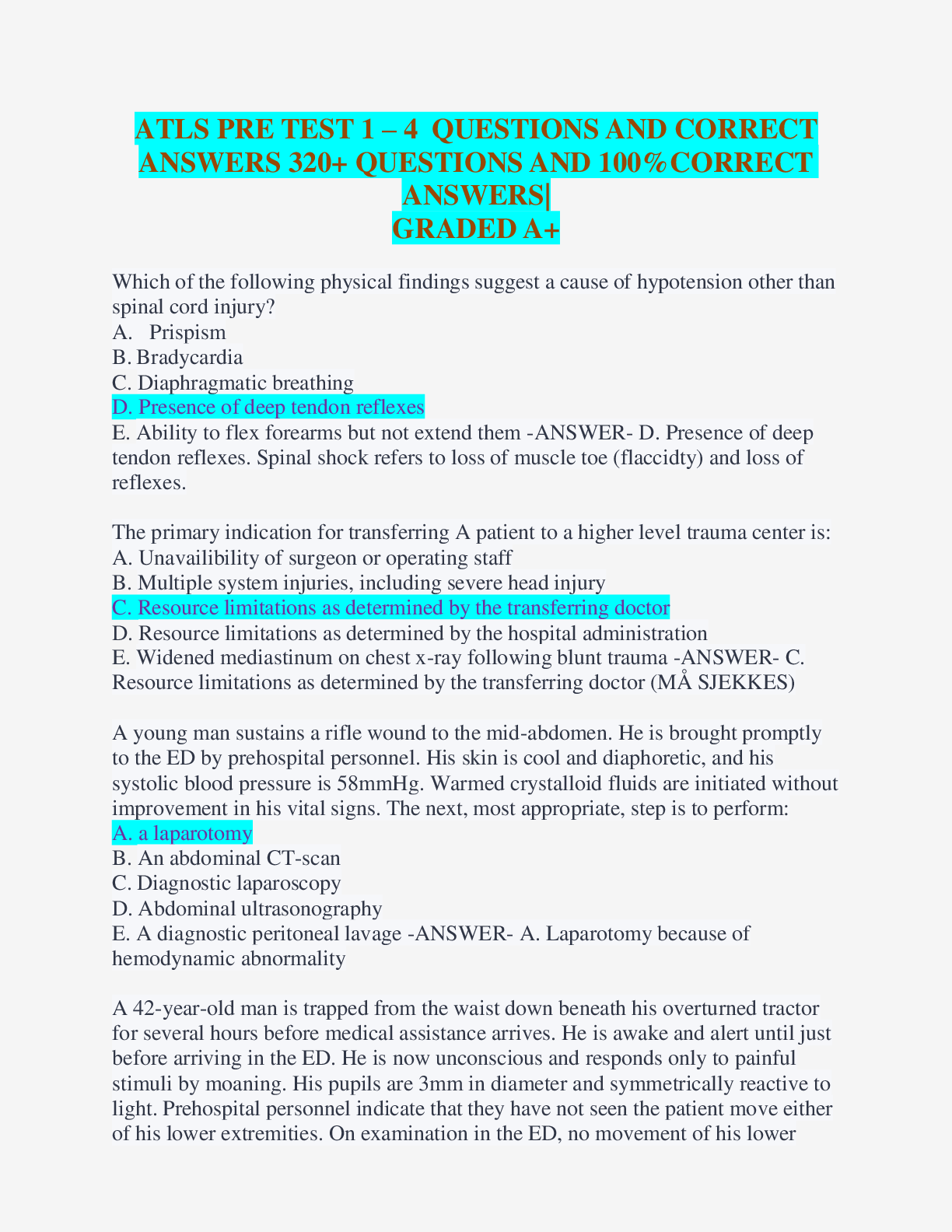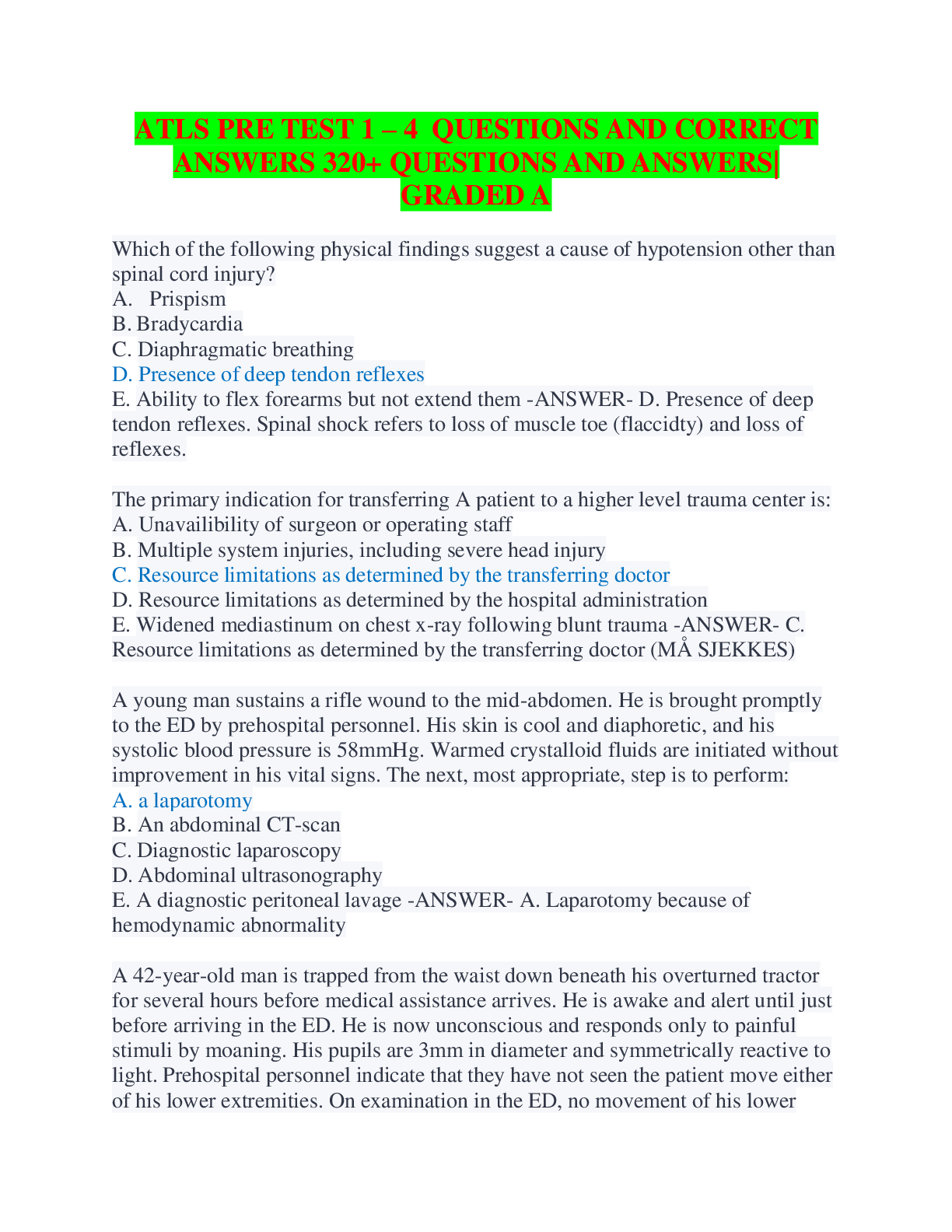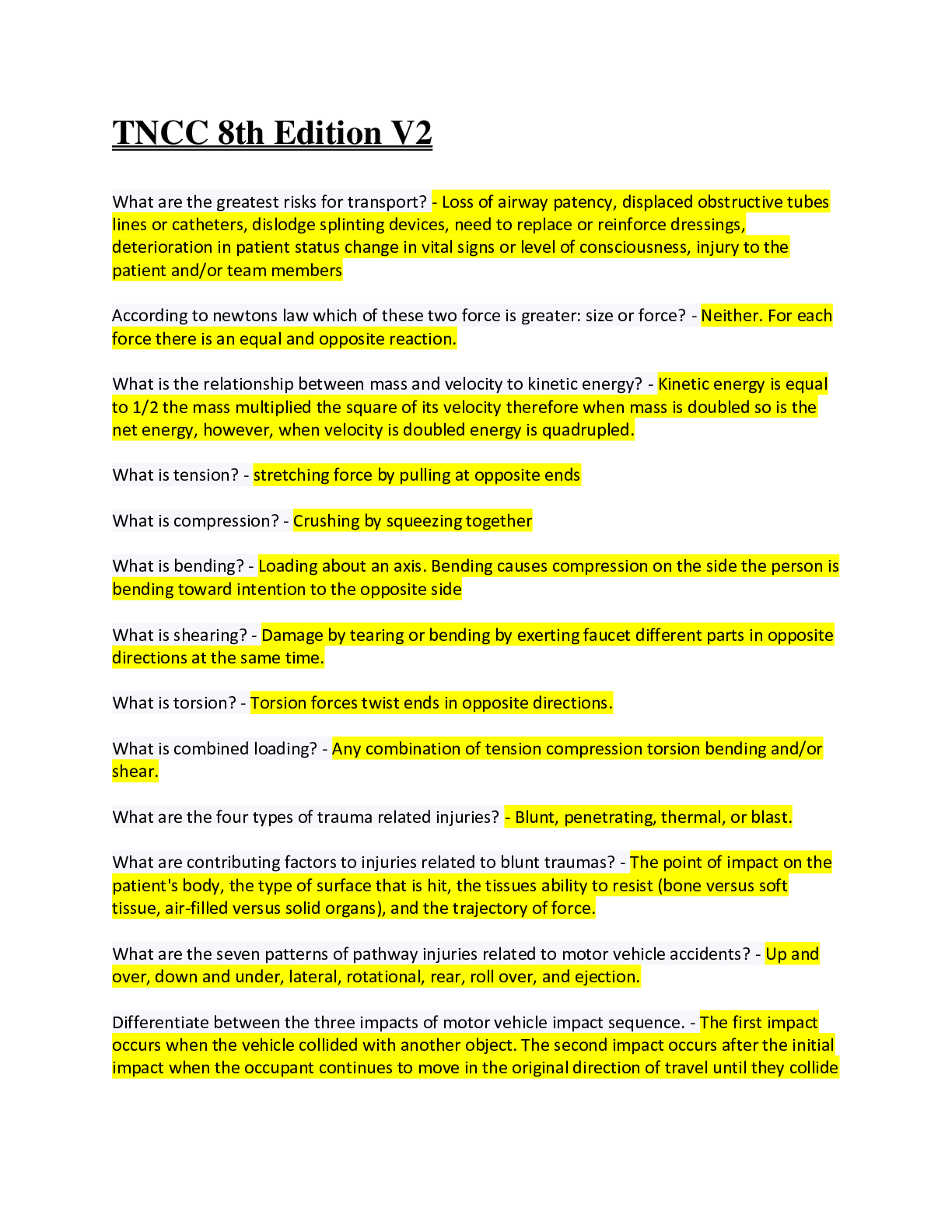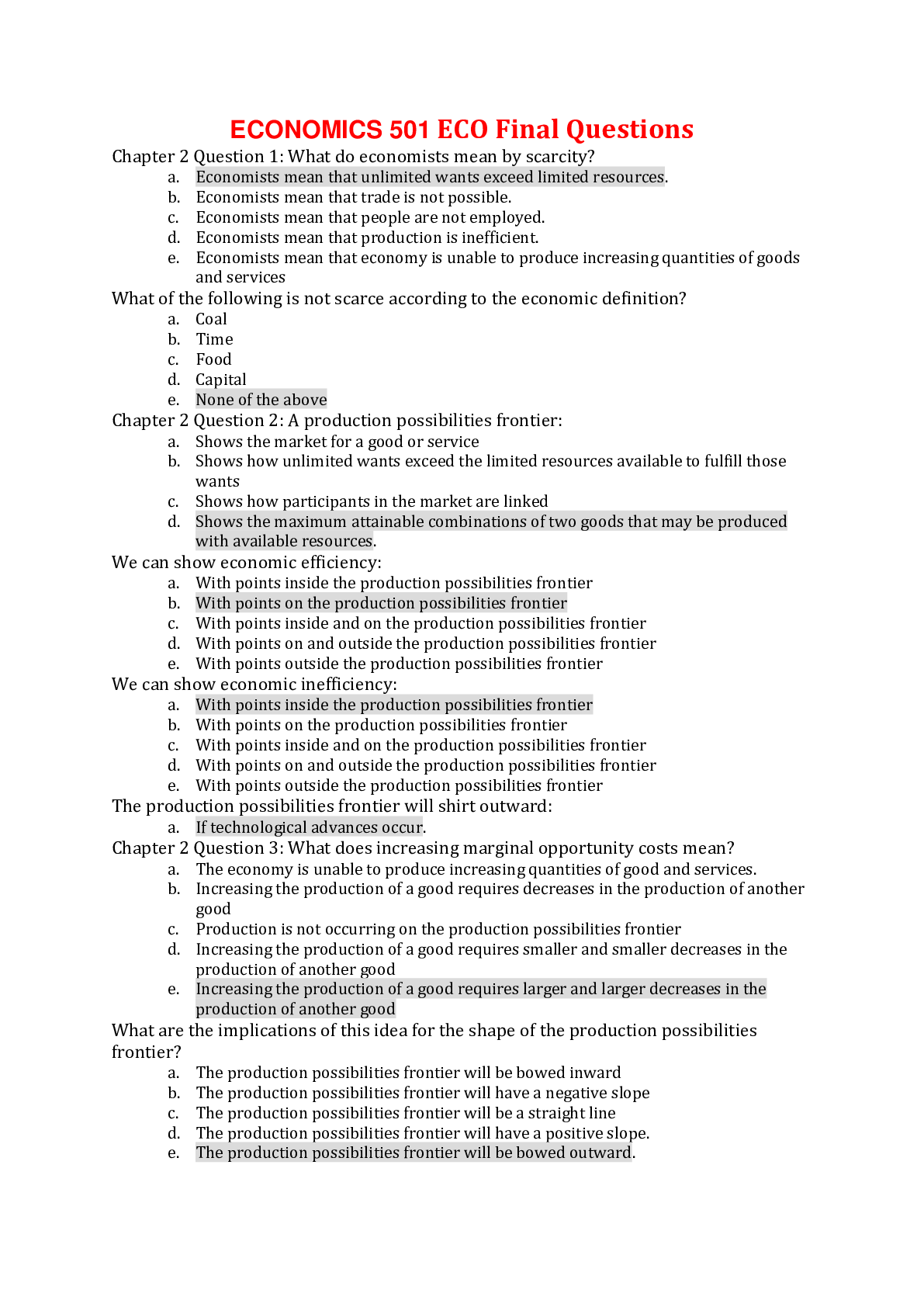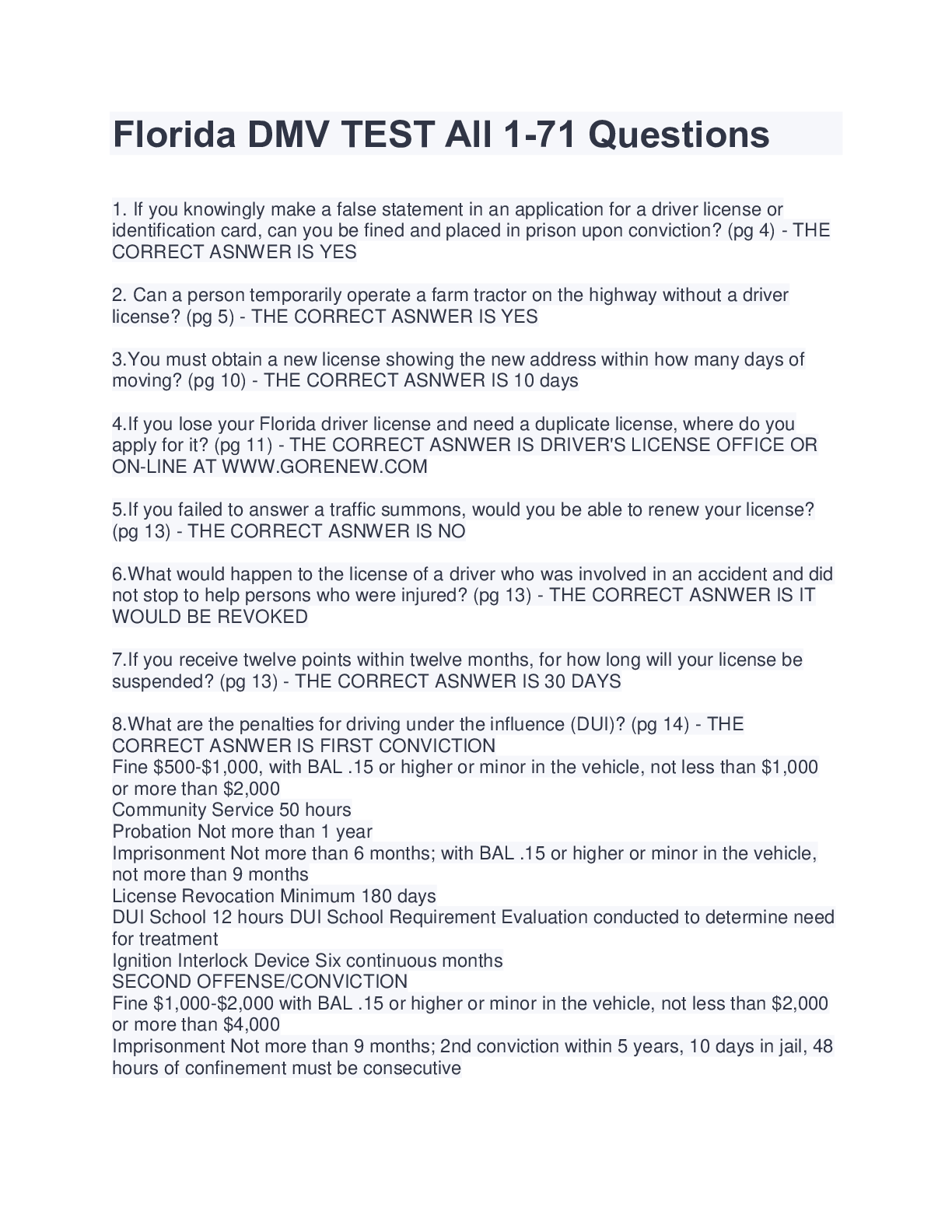*NURSING > EXAM > NURS 274 NCLEX QUESTION TRAINER Test 1 – Medgar Evers College | NURS274 NCLEX QUESTION TRAINER Tes (All)
NURS 274 NCLEX QUESTION TRAINER Test 1 – Medgar Evers College | NURS274 NCLEX QUESTION TRAINER Test 1
Document Content and Description Below
NURS 274 NCLEX QUESTION TRAINER Test 1 – Medgar Evers College TEST 1 1. The nurse is caring for clients in the outpatient clinic. Which of the following messages should the nurse return FIRST? ... 1. A mother reports that the umbilical cord of her five-day-old infant is dry and hard to the touch. 2. A mother reports that the “soft spot” on the head of her four-day-old infant feels slightly elevated when the baby sleeps. 3. A mother reports that the circumcision of her 3-day-old infant is covered with yellowish exudate. 4. A father reports that he bumped the crib of his two-day-old infant and she violently extended her extremities and returned to them their previous position. 2. The parents of a child with hemophilia want to know the cause of the disease. Which of the following would be the BEST response by the nurse? 1. “The father transmits the gene to his son.” 2. “Both the mother and the father carry a recessive trait.” 3. “The mother transmits the gene to her son.” 4. “There is a 50% chance that the mother will pass the trait to each of her daughters.” 3. A six-month-old is brought to the clinic for a well-baby check-up. During the exam, the nurse should expect to assess which of the following? 1. A pincer grasp. 2. Sitting with support. 3. Tripling of the birth weight. 4. Presence of the posterior fontanelle. 4. A 48-year-old man with an endotracheal tube needs suctioning. Which of the following statements is an accurate description of how the nurse should perform the procedure? 1. Insert the suction catheter four inches into the tube. Apply suction for 30 seconds, using a twirling motion as the catheter is withdrawn. 2. Hyperoxygenate the client and then insert the suction catheter into the tube. Suction while you remove the catheter using a back and forth motion. 3. Explain the procedure to the patient. Insert the catheter while gently applying suction, and withdraw using a twisting motion. 4. Insert the suction catheter until resistance is met, then withdraw it slightly. Apply suction intermittently as the catheter is withdrawn. 5. A 47-year-old woman comes to the outpatient psychiatric clinic for treatment of a fear of heights. The nurse knows that phobias involve 1. projection and displacement. 2. sublimation and internalization. 3. rationalization and intellectualization. 4. reaction formation and symbolization. 6. The prenatal client at eight-weeks gestation has a positive VDRL. In preparing the teaching plan, which of the following would be MOST appropriate for the nurse to include? 1. The importance of not taking any medications so as not to damage the fetus. 2. Instructing the client on the importance of taking the penicillin for the prescribed time. 3. Instructing the client to refrain from sexual activity. 4. Maintaining the confidentiality of sexual partners or contacts. 7. An elderly client who has been recently immobilized is ordered to begin passive range-of-motion (ROM) exercises. What should the nurse understand about ROM before initiating this order? 1. Passive range-of-motion exercises increase muscle strength. 2. A full range of motion must be completed for the elderly client . 3. Exercises should be completed to the point of discomfort. 4. A sufficient range of motion assists the elderly to carry out activities of daily living (ADLs). 8. A 65-year-old man is scheduled for a colon resection this morning. Last night he had polyethylene glycolelectrolyte solution (GoLytely) and a soapsuds enema. This morning he passes a medium amount of soft, brown stool. The nurse should know that this 1. indicates that the bowel preparation is incomplete. 2. is evidence that the patient ate something after midnight. 3. is an expected finding before this type of surgery. 4. is the last stool that was left in the colon. 9. The nurse cares for a newborn infant with fetal alcohol syndrome. The nurse would expect to see which of the following physical characteristics? 1. An infant that is large for gestational age (LGA) with craniofacial abnormalities and hydrocephalus . 2. An infant with a small head circumference, low birth weight, and undeveloped cheekbones. 3. An infant with a small head circumference, low birth weight, and excessive rooting and sucking behaviors. 4. An infant with a normal head circumference, low birth weight, and respiratory distress syndrome. 10. The physician orders hydromorphone hydrochloride (Dilaudid) 15 mg IM for a 56-year-old woman. Side effects of this medication that the nurse should observe the patient for include 1. photosensitivity and constipation. 2. hypotension and respiratory depression. 3. tardive dyskinesia and diplopia. 4. dry mouth and tinnitus. 11. The outpatient clinic nurse is caring for a 66-year-old woman with insulin-dependent diabetes mellitus (IDDM). Because the client is unwilling to perform blood glucose monitoring, she tests her urine for sugar and acetone. The nurse knows that blood glucose monitoring is preferred over urine testing for glucose because 1. the renal threshold for glucose is elevated in the elderly. 2. blood glucose monitoring is easier and less costly for clients to perform. 3. urine testing for glucose provides false-positive readings. 4. determination of the color on a reagent strip varies from person to person. 12. At 32-weeks gestation, a client has an order for an ultrasound. The client indicates an understanding of this procedure if she makes which of the following statements to the nurse? 1. “The results will inform us of the gestational age.” 2. “This test will evaluate the baby’s lungs.” 3. “The test will show us if there is any problem in the spinal cord.” 4. “Early problems with the baby’s blood can be identified with this test.” 13. A child has pediculosis capitis (head lice) and is being treated with 1% gamma benzene hexachloride (Kwell) shampoo. The nurse should explain to the child’s parents that 1. treatment should be continued every other day for 1 week. 2. clothing and personal belongings require normal cleansing with soap and water. 3. application of the shampoo is repeated in 7 to 10 days. 4. one treatment with Kwell kills both lice and nits. 14. The nurse is supervising an LPN/LVN who is administering an enema to a patient. During the administration, it is MOST important for the LPN/LVN to take which of the following actions? 1. Place the solution 20 inches above the anus. 2. Adjust the temperature of the solution. 3. Insert the tube six inches. 4. Position the patient left side-lying (Sim’s) with knee flexed. 15. An 18-month-old is admitted to the unit with a diagnosis of laryngotracheobronchitis (LTB). During the initial assessment, the nurse should expect to find which of the following early symptoms? 1. Kussmaul respirations and bradycardia. 2. Elevated temperature and slow respiratory rate. 3. Expiratory wheezing and substernal retractions. 4. Inspiratory stridor and restlessness. 16. A client has been receiving chlorpromazine hydrochloride (Thorazine). When the nurse checks on the patient, the patient is restless, unable to sit still, and complains of insomnia and fine tremors of her hands. The nurse knows that these symptoms are 1. a side effect of the medication that she will tolerate better as time passes. 2. the reason she is receiving this medication. 3. extrapyramidal side effects resulting from this medication. 4. an indication that the dosage of the medication needs to be increased. 17. The nurse is caring for a client with a tracheostomy. An appropriate nursing diagnosis for this client is 1. impaired verbal communication related to absence of speaking ability. 2. ineffective airway clearance related to increased tracheobronchial secretions. 3. risk for impaired skin integrity related to tracheostomy incision. 4. alteration in comfort: pain related to tracheostomy. 18. Which of the following types of foods should the nurse encourage in the diet of a client with hypoparathyroidism? 1. High in phosphorus. 2. High in calcium. 3. Low in sodium. 4. Low in potassium. 19. A 20-year-old woman arrives at the hospital in active labor. The admitting nurse attaches an internal fetal monitor. The nurse knows the MOST important reason for the fetal monitor is 1. to evaluate the progress of the client’s labor. 2. to assess the strength and duration of the client’s contractions. 3. to monitor the oxygen status of the fetus during labor. 4. to decide if an oxytocin drip is necessary. P R E P A R A T I O N F O R T H E N URSING L I C E N S U R E E XAMINATION................................................ 20. A mentally retarded client is to be discharged home on warfarin sodium (Coumadin), 5 mg each day. To maintain client safety, which of the following would be an appropriate FIRST nursing action? 1. Instruct a significant other about the medication regimen. 2. Evaluate client comprehension of the medication administration. 3. Prepackage the medication to encourage correct administration. 4. Encourage a return demonstration of medication self-administration. 21. A client, gravida 2 para 1, is admitted with hypertension and complains that her wedding band is tight. The nurse should expect to assess which of the following with early pre-eclampsia? 1. Blurred vision and proteinuria. 2. Epigastric pain and headache. 3. Facial swelling and proteinuria. 4. Polyuria and hypertonic reflexes. 22. The nurse is caring for clients in a drug rehabilitation facility. Which of the following complications of IV drug abuse is the nurse MOST likely to observe? 1. Jaundice. 2. Rash. 3. Bruising. 4. Cellulitis. 23. The client is admitted with cerebrovascular accident (CVA) and has facial paralysis. Nursing care should be planned to prevent which of the following complications? 1. Inability to talk. 2. Inability to swallow caused by loss of the gag reflex. 3. Inability to open the affected eye. 4. Corneal abrasion. 24. A client is ordered to take aspirin gr. X, PO. The drug label reads: “Aspirin 325 mg per tablet.” Which of the following actions should the nurse take? 1. Request that the pharmacy send a correctly labeled medication. 2. Notify the doctor regarding the dosage. 3. Give one tablet. 4. Give two tablets. 25. The nurse recognizes which of the following as early signs of lithium toxicity? 1. Restlessness, shuffling gait, involuntary muscle movements. 2. Ataxia, confusion, seizures. 3. Fine tremors, nausea, vomiting, diarrhea. 4. Elevated white blood cell count, orthostatic hypotension. 26. The nurse suggests that the client not eat or drink anything just before going to bed. The appropriateness of this comment is based on which of these understandings about a sliding hiatal hernia? 1. The client is less likely to awaken during the night with heartburn if the stomach is empty. 2. Early morning vomiting will be less of a problem if the stomach is empty. 3. Drinking or eating before lying down causes decreased respirations due to increased pressure on the lungs. 4. The client may develop fluid overload if fluids are taken just before going to bed. 27. A new mother is taking her infant home. The client asks the nurse when she should start giving her child solid foods. The nurse’s response should be based on which of the following statements? 1. Rice cereal is usually the first solid food and is started around four to five months. 2. Strained fruits are well tolerated as the first solid food, and infants like them. 3. Introduction of solid foods is not important at this time. 4. Solid foods are usually not started until the infant is around six months old. 28. The client has an order for IV fluid of D5 0.45% normal saline 1,000 cc to run from 9 AM to 9 PM. The drip factor on the delivery tubing is 15 gtts/min. The nurse should adjust the IV to infuse at 1. 12 gtts/min. 2. 21 gtts/min. 03. 25 gtts/min. 4. 31 gtts/min. 29. The nurse understands that the primary reason elderly adults have problems with constipation is that they 1. eat a small volume of food with decreased bulk. 2. have less activity and decreased muscle tone. 3. have neurological changes in the gastrointestinal tract. 4. have decreased sensation in the gastrointestinal tract. 30. The nurse is discussing growth and development with the parents of a four-year-old child. The nurse should identify which of the following as the type of play characteristic of this age group? 1. Solitary play. 2. Parallel play. 3. Associative play. 4. Aggressive play. 31. Which of the following should be charted by the nurse to reflect a client’s emotional adjustment to being hospitalized in the intensive care unit? 1. “The client is unable to complete activities of daily living without assistance. ” 2. “The client appears to be depressed and anxious regarding his/her surgery.” 3. “The client constantly calls for nurses, pleads for them to stay at the bedside, and cries uncontrollably.” 4. “The family is unable to visit more often than once a week because they live far away.” 32. Which nursing observation would suggest that a client has developed an Addisonian crisis? 1. Muscular weakness and fatigue. 2. Restlessness and rapid, weak pulse. 3. Dark pigmentation of the skin . 4. Gastrointestinal disturbances and anorexia. 33. During the fourth stage of labor, the nurse should palpate the fundus: 1. three cm below the umbilicus. 2. at the umbilicus. 3. two cm above the umbilicus. 4. to the right of the umbilicus. 34. A postoperative cataract client is cautioned about not making sudden movements or bending over. The nurse understands that the rationale for this recommendation is to prevent which of the following? 1. Impairment of cerebral blood flow and headaches . 2. Increased intracranial pressure. 3. Pressure on the ocular suture line. 4. Displacement of the lens implant. 35. Which information should the nurse recognize as being the MOST pertinent to the diagnosis of cholecystitis? 1. Flatulence. 2. Nausea and vomiting. 3. Right upper abdominal pain. 4. Dyspepsia. 36. Which of the following might alert the nurse to consider an alcohol problem in a client hospitalized for a physical illness? 1. Depression, difficulty falling asleep, decreased concentration. 2. Elevated liver enzymes, cirrhosis, decreased platelets. 3. Tremors, elevated temperature, complaints of nocturnal leg cramps, complaints of pain symptoms. 4. Flulike symptoms, diarrhea, night sweats, elevated temperature, decreased deep tendon reflexes. 37. A 7-year-old girl is seen in the clinic with a diagnosis of pituitary dwarfism. Which of the following clinical manifestations is the nurse MOST likely to observe? 1. Abnormal body proportions. 2. Early sexual maturation. 3. Delicate features. 4. Coarse, dry skin. 38. The physician orders mannitol (Osmitrol) for a client with a closed head injury. Which of the following should the nurse recognize as the desired response to this medication? 1. The blood pressure increases to 150/90. 2. Urinary output increases to 175 cc/hour. 3. There is a decrease in the level of activity. 4. There is absence of fine tremors of the fingers. 39. The nurse knows that according to Erikson’s stages of psychosocial development, which of the following best represents a 50-year-old client? 1. Integrity versus despair and disgust. 2. Generativity versus stagnation. 3. Intimacy versus isolation. 4. Identity versus role diffusion. 40. A 54-year-old client developed a postoperative infection and has been receiving ceftriaxone sodium (Rocephin) IV every day. It is MOST important for the nurse to monitor which of the following? 1. The surface of the tongue. 2. Hemoglobin and hematocrit. 3. Skin surfaces in skin folds. 4. Changes in urine characteristics. 41. The nurse should caution the client with hypothyroidism to avoid 1. warm environmental temperatures. 2. narcotic sedatives. 3. increased physical exercise. 4. a diet high in fiber. 42. The nurse performs the Rinne tests on a 6-year-old girl. Which of the following is an accurate statement of how this test should be performed? 1. The stem of a vibrating tuning fork is held against the auditory canal until the child indicates that she can no longer hear the sound. Then the tuning fork is moved away from the canal. 2. The stem of a vibrating tuning fork is held against the mastoid bone until the child indicates that she can no longer hear the sound. Then the tuning fork is moved in front of the auditory canal. 3. The stem of a vibrating tuning fork is held in the middle of the forehead and the girl’s hearing is assessed in both ears. 4. The stem of a vibrating tuning fork is positioned two inches behind the girl’s head, and the length of time she hears the sound is documented. 43. The nurse would explain to the diabetic client that the decreased vision he has experienced is due to which of the following? 1. Bleeding into the inner ocular chamber of the eye. 2. Gradual separation of the retina from the base of the eye. 3. An increase in the size of the vessels in the back of the eye. 4. Gradual destruction and degeneration of the retina. 44. A woman is being evaluated for infertility. The doctor gives the client clomiphene citrate (Clomid) 50 mg daily for five days. The client says to the nurse, “What is the purpose of this medicine?” The nurse should instruct her that the action of medication is to 1. induce ovulation by changing hormonal effects on the ovary. 2. change the uterine lining to be more conducive to implantation. 3. alter the vaginal pH to increase sperm motility. 4. produce multiple pregnancy for those who desire twins. 45. A client had a kidney transplant yesterday. The client’s son has come to visit. The nurse should instruct the son to do which of the following? 1. No special isolation techniques are necessary. 2. Wear a double mask and gloves. 3. Perform good hand washing. 4. Wear a gown and a mask. 46. The physician orders naproxen sodium (Naprosyn) for a 77-year-old man. The nurse should assess the patient for 1. stomatitis and photosensitivity. 2. brachycardia and dry mouth. 3. fluid retention and dizziness. 4. gynecomastia and impotence. 47. The nurse is caring for a postoperative client whose diabetes has been controlled with oral antihyperglycemic agents in the past. The client asks why the physician ordered subcutaneous insulin injections after surgery. The nurse’s response should be based on which of the following statements? 1. Tissue injury after surgery decreases blood sugar. 2. Anesthesia acts to increase glycogen stores. 3. Being NPO inhibits normal blood sugar control. 4. Surgery often leads to insulin dependency. 48. Which of the following would be MOST important for the rehabilitation nurse to assess during a new client’s admission? 1. The client’s expectations of family members. 2. The client’s understanding of available supportive services. 3. The client’s personal goals for rehabilitation. 4. The client’s past experiences in the hospital. 49. The nurse knows that Cortisol is responsible for 1. preparing the body for “flight or fight.” 2. regulating the calcium metabolism. 3. converting proteins and fat into glucose. 4. enhancing musculoskeletal activity. 50. A middle-aged man is admitted to an inpatient psychiatric unit. Over the last several months he has become convinced that his brother is trying to steal his property. He is diagnosed with paranoid disorder. The nurse knows that this client is demonstrating which of the following? 1. Delusions of persecution. 2. Command hallucinations. 3. Delusions of reference. 4. Persecution hallucinations. 51. The nurse is administering oral verapamil (Isoptin) to a client. Before administering the verapamil the nurse should check the client’s 1. electrolytes. 2. urine output. 3. weight. 4. heart rate. 52. The nurse knows which of the following mood-altering drugs is most often associated with an increased risk for HIV infection related to intravenous drug use? 1. Benzodiazepines . 2. Marijuana. 3. Barbiturates. 4. Narcotics. 53. The nurse is teaching a parenting class to a group of expectant mothers. The nurse should advise that the breastfeeding mother should increase her daily caloric intake by how many calories? 1. 200. 2. 300. 3. 400. 4. 500. 54. The physician writes an order for a STAT dose of Demerol 50 mg IM for pain. Three hours later the client again complains of pain, and the nurse administers a second injection of Demerol. Which of the following describes the nurse’s liability? 1. The nurse administered the medication appropriately; there is no liability. 2. The nurse violated the narcotic law in not having an order to administer the Demerol a second time. 3. The client was not injured; if injury did not occur, then the nurse is not liable. 4. The nurse should have waited at least four hours; then there would be no liability. 55. The nurse is caring for a patient with a pneumothorax resulting from an auto accident three days ago. He has a chest tube connected to a three-chamber water-seal drainage system (Pleur-evac) with 20 cm suction. How would the nurse know if the lung had re-expanded? 1. There is no drainage in the collection chamber for three hours. 2. The fluid in the water-seal chamber does not fluctuate with respirations. 3. There is continuous bubbling in the water-seal chamber. 4. There is gentle bubbling in the suction-control chamber. 56. The nurse on a psychiatric unit of the hospital refuses to agree to a 32-year-old patient’s request to organize a party on the unit with his friends. The patient becomes angry and uses abusive language with the nurse. Which of the following statements indicates that the nurse has an understanding of the patient’s behavior? 1. Allowing the patient to use abusive language will undermine the authority of the nurse. 2. Responding in kind to a patient who uses abusive language will perpetuate the behavior. 3. Abusive language is one of the behaviors that is a symptom of the patient’s illness. 4. The nurse should model acceptable behavior and language for all patients. 57. The nurse is caring for a three-month-old infant that is scheduled for a barium swallow in the morning. Prior to the procedure, the MOST appropriate nursing action would be to 1. offer the infant only clear liquids. 2. make the infant NPO for three hours. 3. feed the infant regular formula. 4. maintain the infant NPO for six hours. 58. The client has been receiving a blood transfusion for approximately 30 minutes. Which of these assessments, if made by the nurse, would indicate an allergic reaction? 1. Hypotension. 2. Chills. 3. Respiratory wheezing. 4. Lower back discomfort. 59. The physician inserts a temporary pacemaker in a 45-year-old man following a myocardial infarction. The nurse knows that the primary purpose of the pacemaker is to 1. increase the force of myocardial contraction. 2. increase the cardiac output. 3. prevent premature ventricular contractions (PVCs). 4. prevent systemic overload. 60. Which of the following instructions should be given by the nurse to an adult client in preparation for a plasma cholesterol screening? 1. Eat a vegetarian diet for one week before the test. 2. Limit alcohol intake to two glasses of wine the day before the test. 3. Abstain from dairy products for 48 hours before the test. 4. Only sips of water should be taken for 12 hours before the test. 61. A toddler with lead poisoning is admitted to the pediatric unit. There is an order to encourage fluids. Which of the following fluids would be the best for the nurse to offer to the child? 1. Milk. 2. Water. 3. Orange juice . 4. Fruit punch. 62. In the process of a normal adjustment to a terminal illness, the nurse knows that the client’s initial denial and isolation will give way to the second stage, which is characterized by 1. acceptance . 2. bargaining. 3. anger . 4. depression. 63. The nurse prepares a 67-year-old man for an intravenous pyelogram (IVP). The client asks the nurse to explain the reason why the procedure is performed. The nurse’s response should be based on the knowledge that the primary purpose of an IVP is to 1. observe the renal pelvis directly . 2. assess glomerulofiltration rate. 3. examine the urinary tract by x-ray. 4. inject medication into the urinary system. 64. The mother of a child with chickenpox asks the physician’s office nurse why her child will not come down with chickenpox again if exposed to the virus at school at a later date. The nurse’s response should be based on the information that 1. natural passive immunity occurs because the child receives antibodies from outside the body. 2. artificial active immunity occurs because the child receives specific antigens against the chickenpox virus. 3. natural active immunity occurs because the child’s body actively makes antibodies against the chickenpox virus. 4. artificial passive immunity occurs because of the inflammatory process of chickenpox. 65. Several days after the delivery of a stillborn, the parents say, “We wish we could talk with other couples who have gone through this trauma.” Which of the following nursing responses would be BEST? 1. “SIDS will provide you with this opportunity.” 2. “SHARE will provide you with this opportunity.” 3. “RESOLVE will provide you with this opportunity.” 4. “CANDLELIGHTERS will provide you with this opportunity.” 66. Which of the following is the BEST way for a nurse to assess the fluid balance of a 70-year-old man? 1. Assess the client’s blood pressure. 2. Check the client’s tissue turgor. 3. Ask the client if he is thirsty. 4. Maintain an accurate intake and output. 67. In planning diet teaching for a child in the early stages of nephrotic syndrome, the nurse should discuss with the parents which of the following dietary changes? 1. Adequate protein intake, low sodium. 2. Low-protein, low-potassium intake. 3. Low-potassium, low-calorie intake. 4. Limited-protein, high-carbohydrate intake. 68. In preparing a teaching plan regarding colostomy irrigations, the nurse should include which of the following? 1. The colostomy needs to be irrigated at the same time every day. 2. Irrigate the colostomy after meals to increase peristalsis. 3. Insert the catheter about 10 inches into the stoma. 4. The solution should be very warm to increase dilation and flow. 69. The nurse knows which of the following would have the greatest impact on an elderly client’s ability to complete activities of daily living (ADLs)? 1. Perseveration. 2. Aphasia. 3. Mnemonic disturbance. 4. Apraxia. 70. Prior to sending a client for a cardiac catheterization, it would be MOST important for the nurse to report which of the following? 1. The client has an allergy to shellfish. 2. The client has diminished palpable peripheral pulses. 3. The client has cool lower extremities bilaterally. 4. The client is anxious about the pending procedure. 71. If a client has ataxia, the MOST important nursing action would be to 1. supervise ambulation. 2. measure the intake and output accurately. 3. consult the speech therapist. 4. elevate the foot of the bed. 72. A 14-year-old girl is brought to the hospital for treatment of second- and third-degree burns sustained in a house fire. An intravenous infusion is started in the patient’s left forearm. The nurse knows that the primary purpose of the IV is to 1. provide a route for pain medications. 2. maintain fluid balance. 3. prevent gastrointestinal upset. 4. obtain blood specimens for analysis. 73. An 80-year-old client is admitted with a possible fractured right hip. During the initial nursing assessment, which of the following observations of the right leg would validate or support this diagnosis? 1. The leg appears to be shortened and is abducted and externally rotated. 2. Plantar flexion is observed with sciatic pain radiating down the leg. 3. From the hip, the leg appears to be longer and is externally rotated. 4. There is evidence of paresis with decreased sensation and limited mobility. 74. The nurse has collected the following data: client anger directed toward staff in the form of frequent sarcastic or crude comments, increased wringing of hands, and purposeless pacing, particularly after the client has used the telephone. Based on this data, the nurse should make which nursing diagnosis? 1. Impaired social interaction related to conversion reaction. 2. Risk for potential activity intolerance as evidenced by purposeless pacing. 3. Powerlessness in hospital situation. 4. Ineffective individual coping related to recent anger and anxiety. 75. The nursing team consists of a RN who has been practicing for six months, a LPN/LVN who has been practicing for 15 years, and a nursing assistant who has been caring for clients for three years. The RN should care for which of the following clients? 1. A client 1 day postop after an internal fixation of a fractured left femur. 2. A client receiving diltiazem (Cardizem) and phenytoin (Dilantin). 3. A client who is to receive 2 units of packed cells prior to an upper endoscopy procedure. 4. A client admitted yesterday with exhaustion and a diagnosis of acute bipolar disorder [Show More]
Last updated: 1 year ago
Preview 1 out of 26 pages
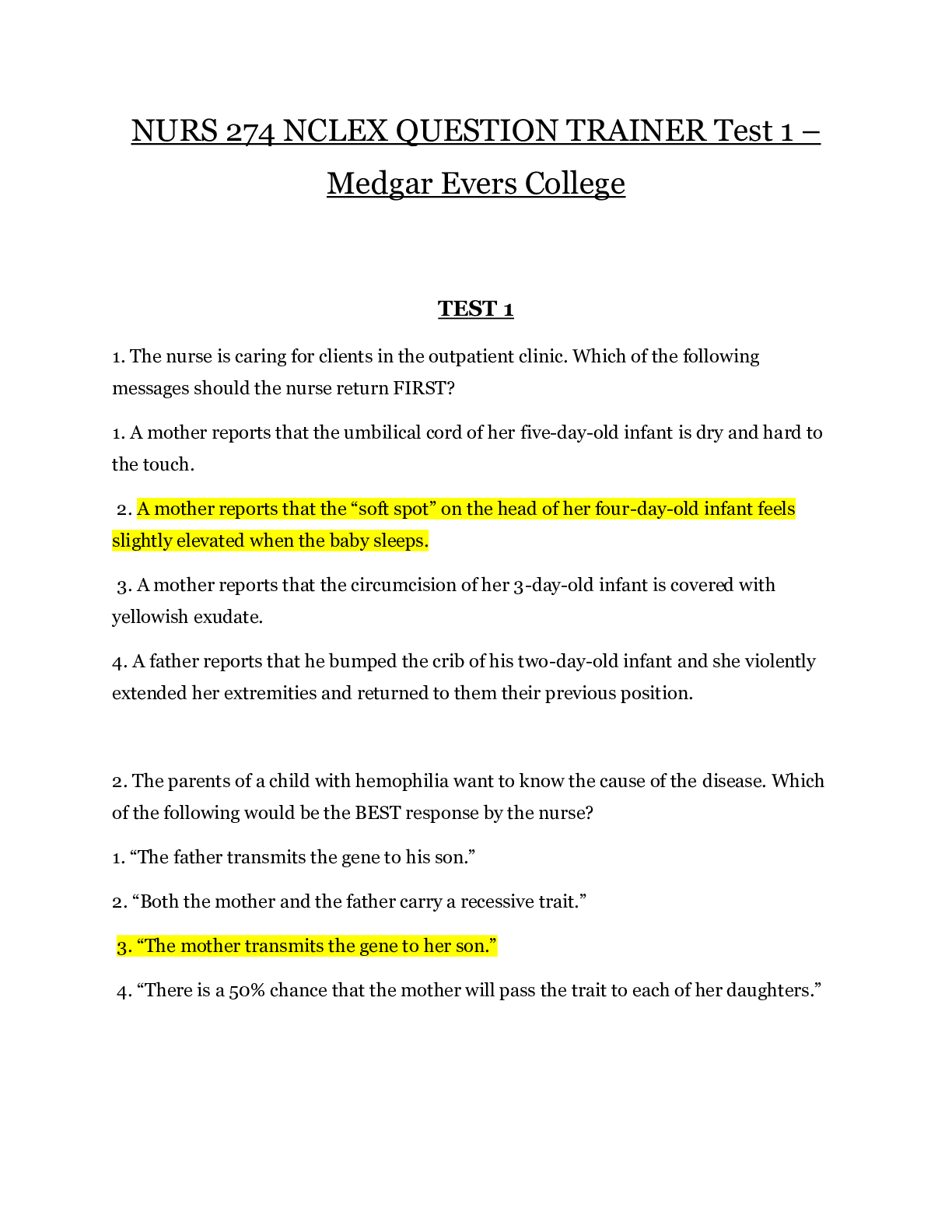
Reviews( 0 )
Document information
Connected school, study & course
About the document
Uploaded On
Nov 27, 2020
Number of pages
26
Written in
Additional information
This document has been written for:
Uploaded
Nov 27, 2020
Downloads
0
Views
122


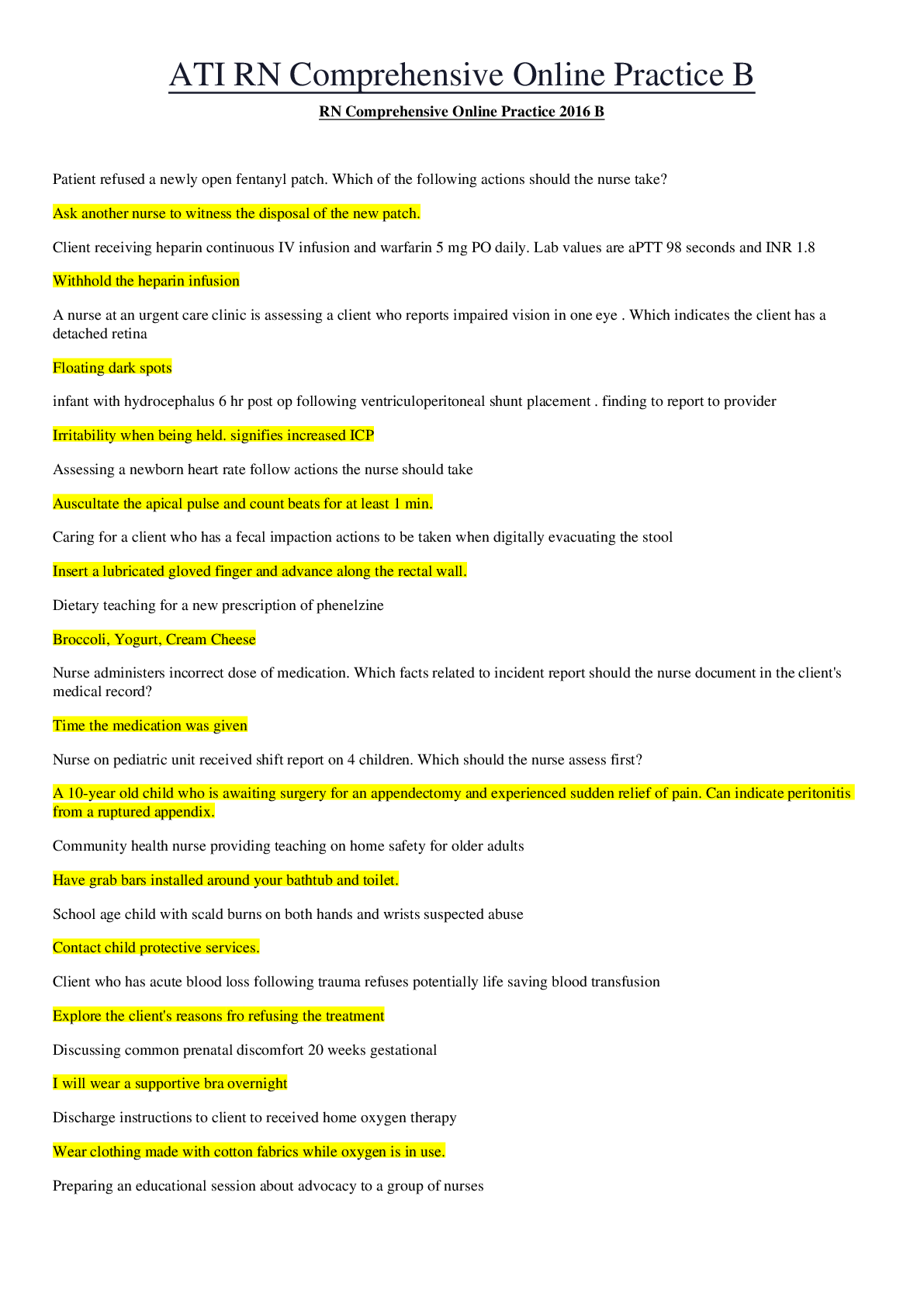
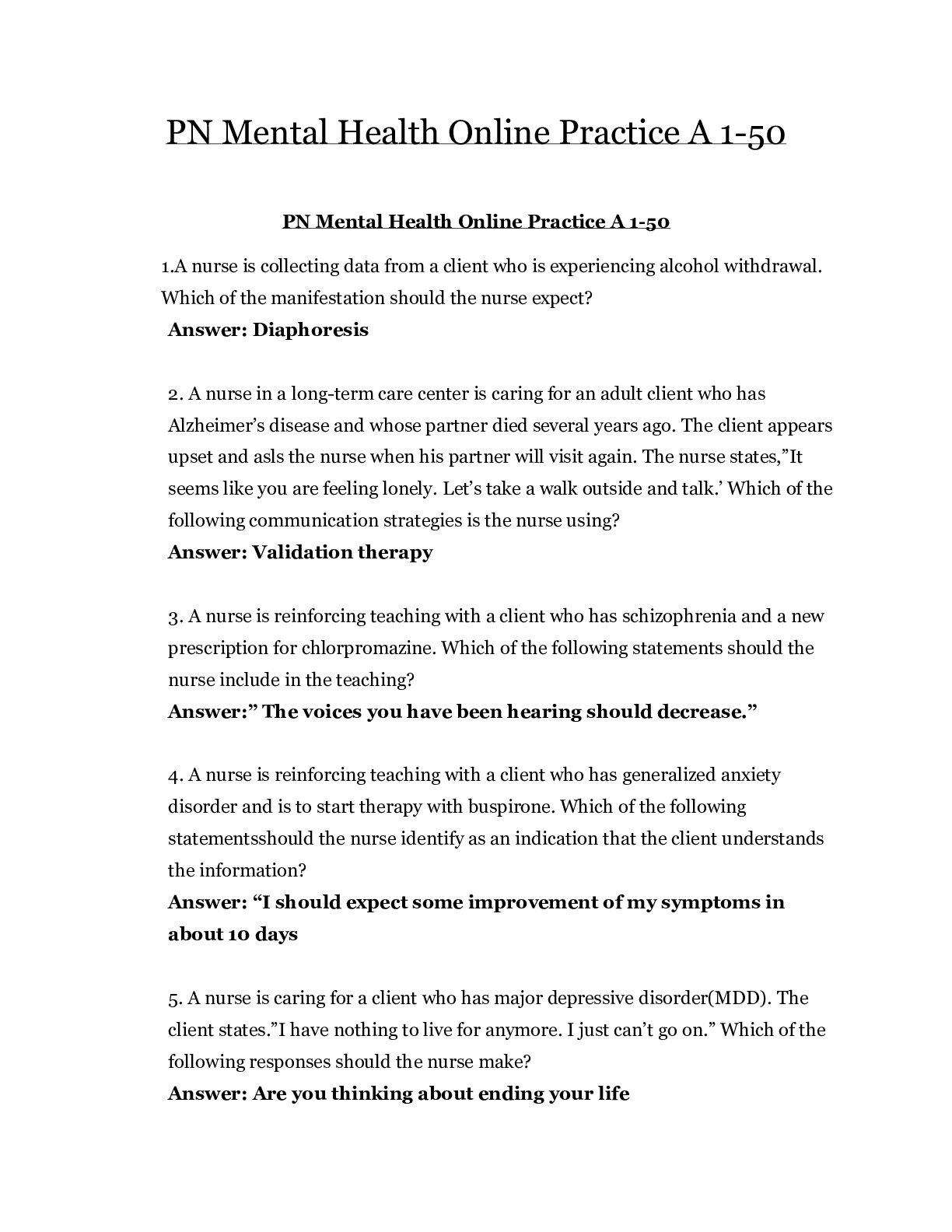
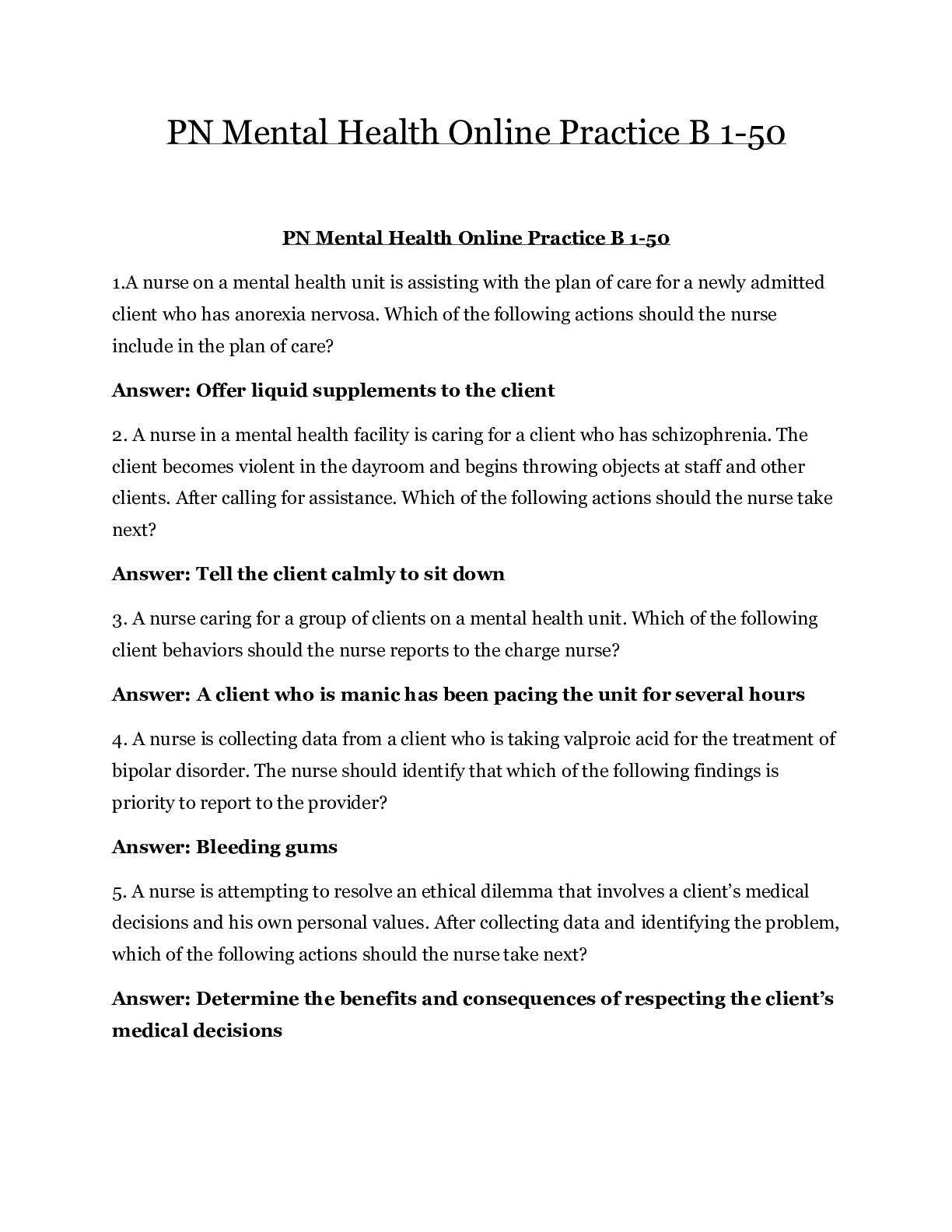
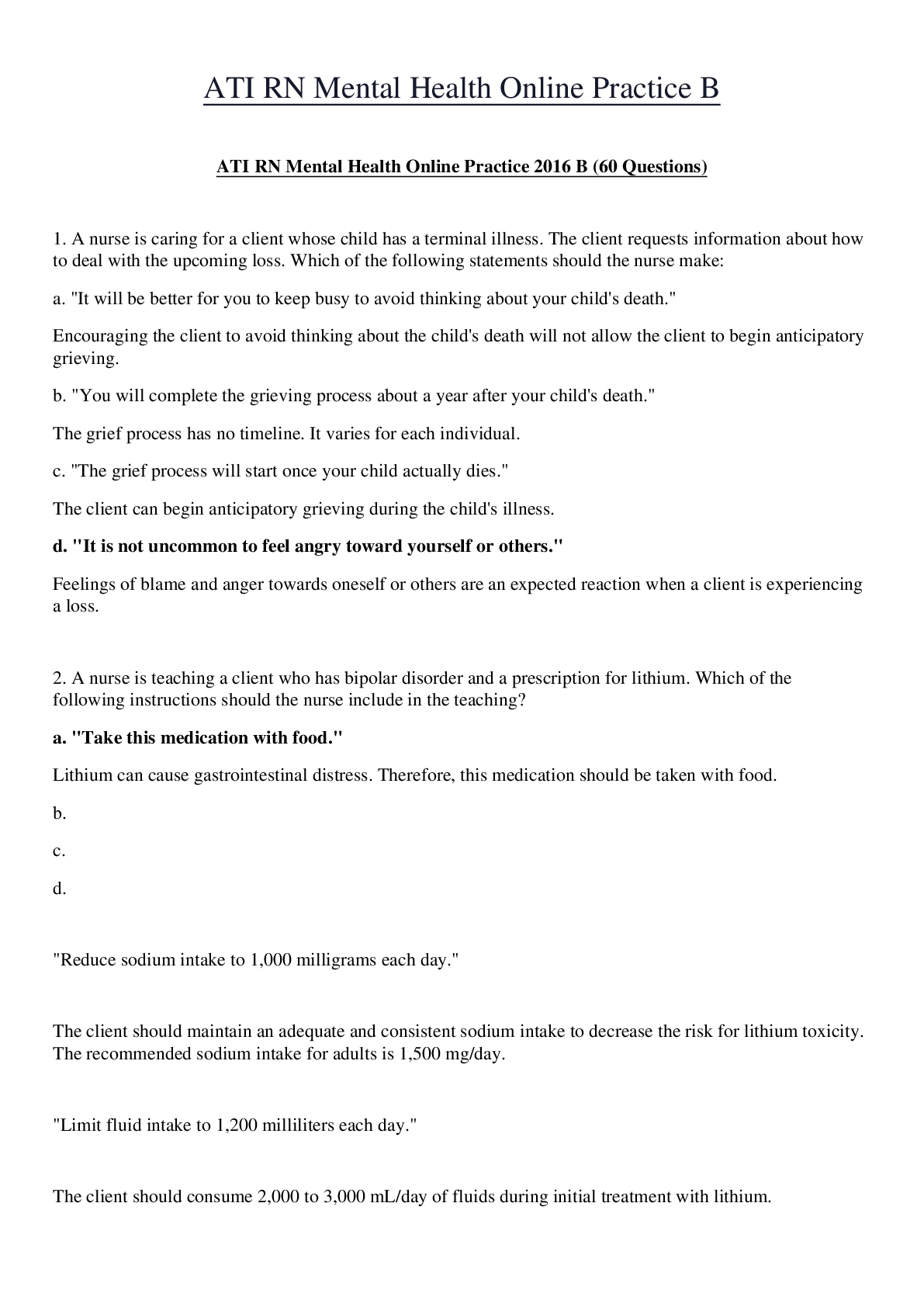


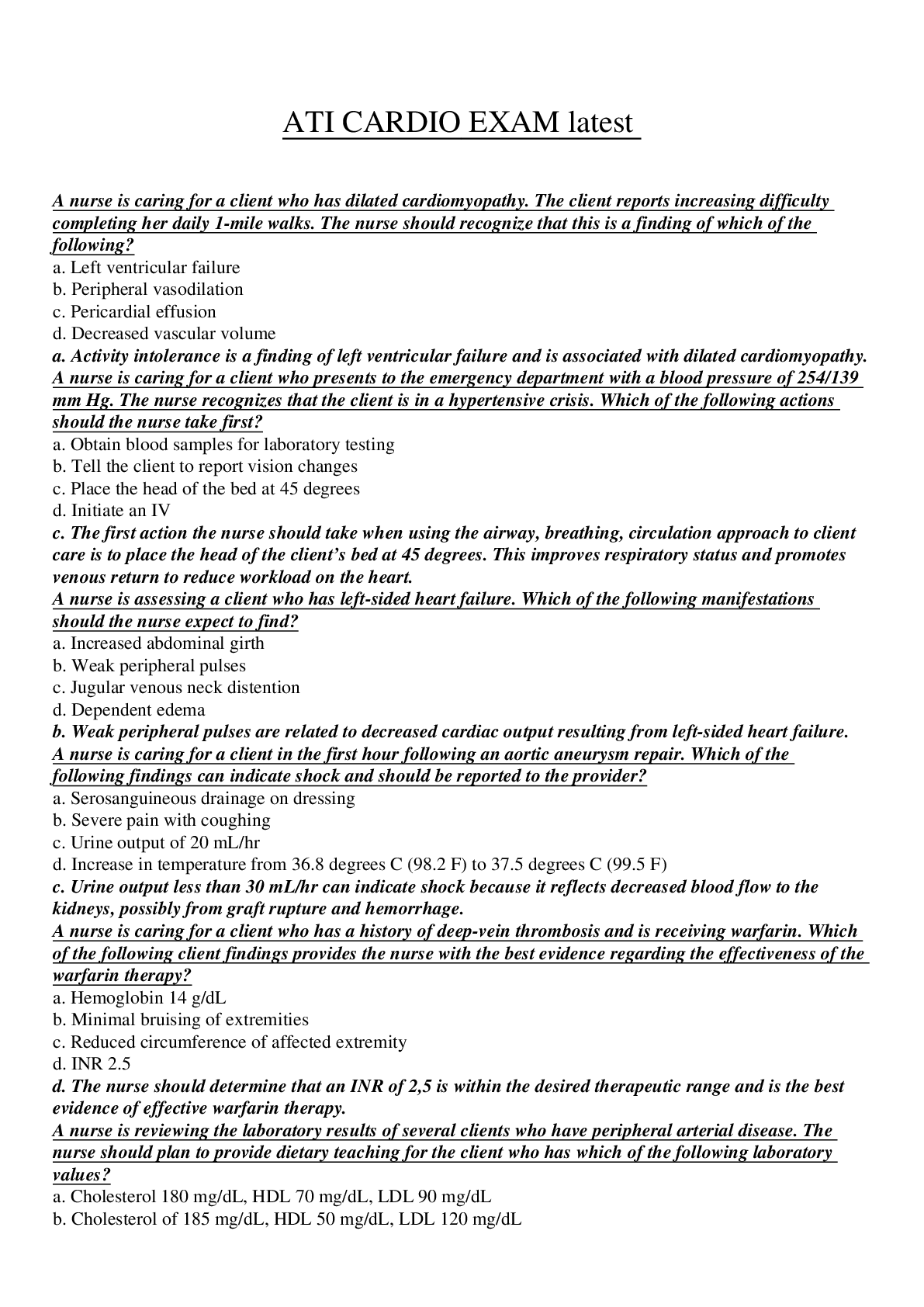
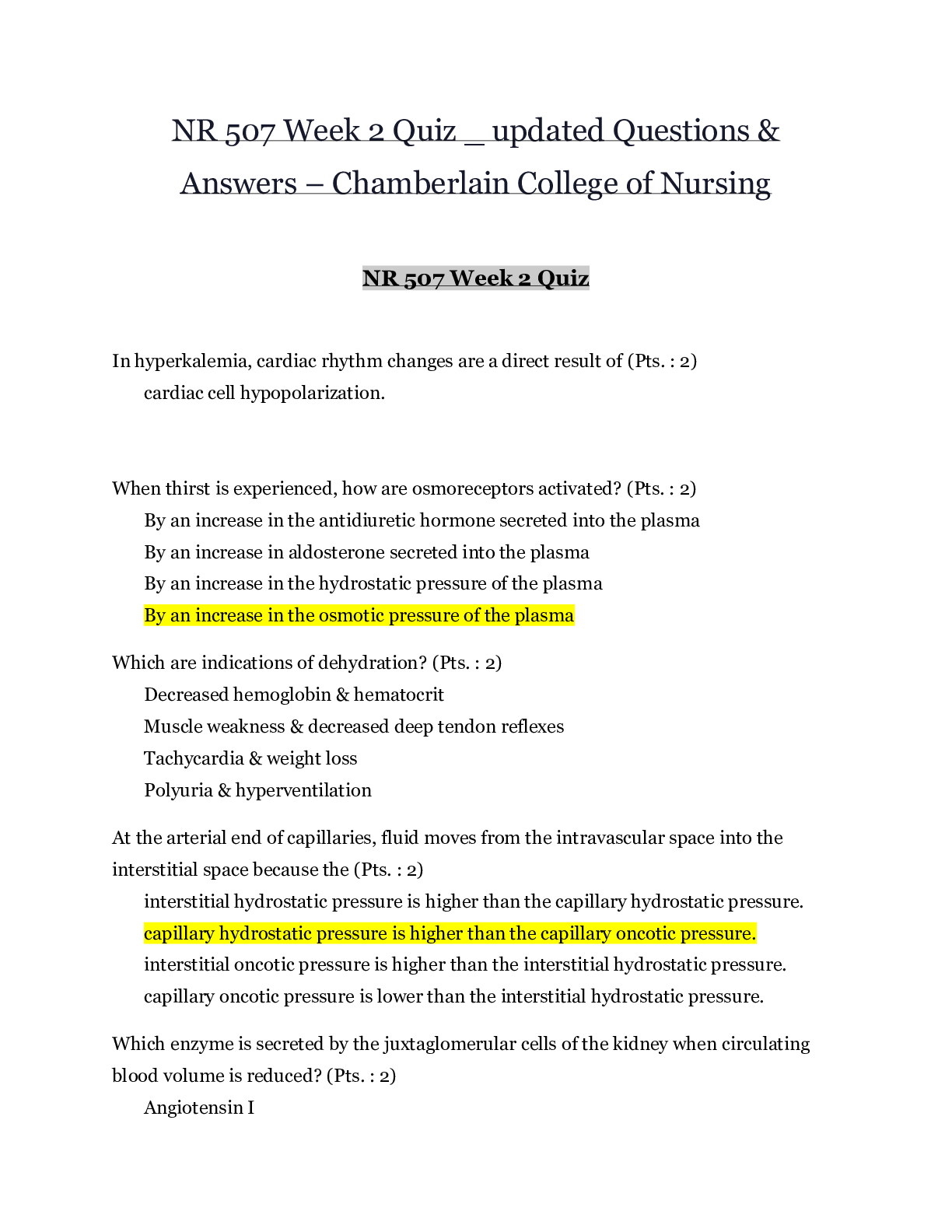
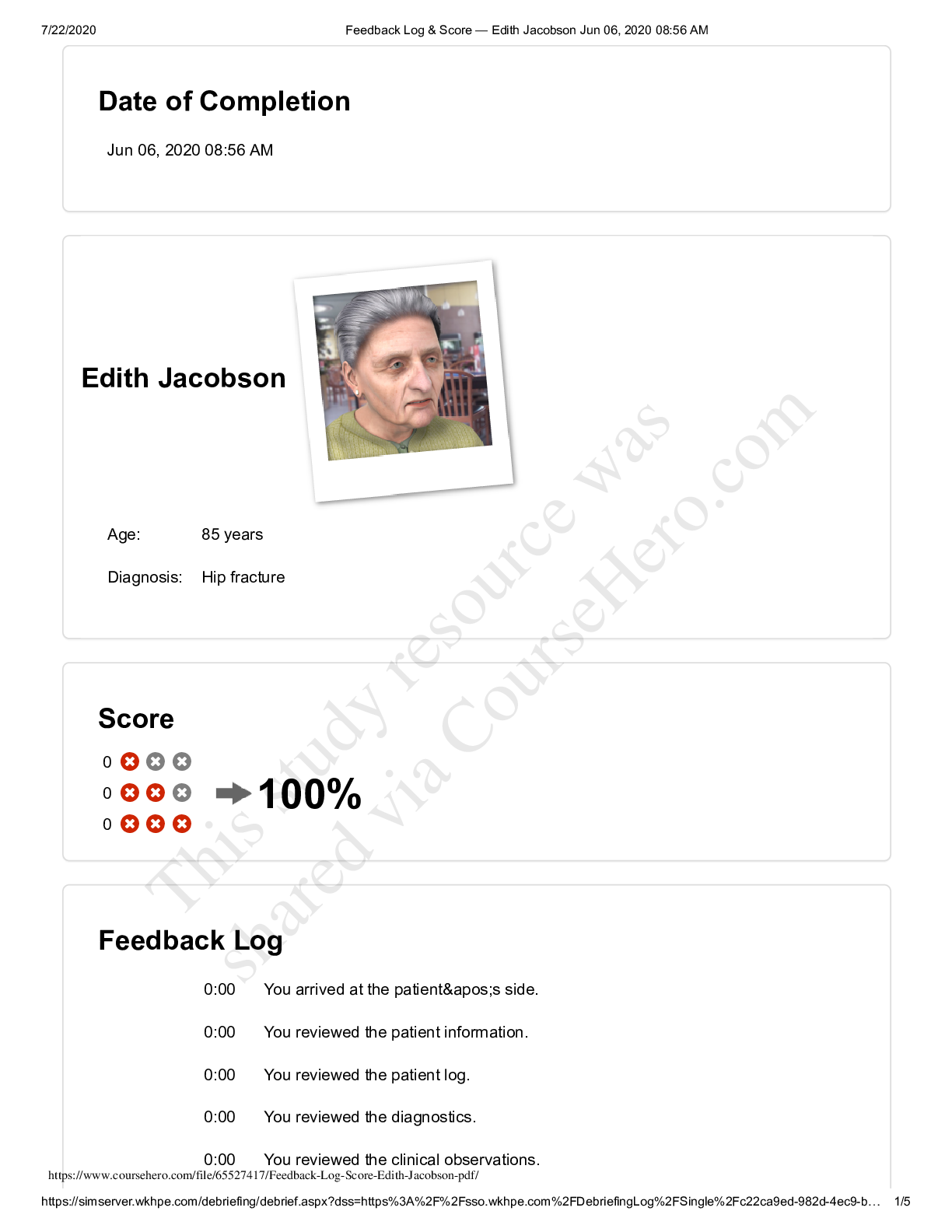
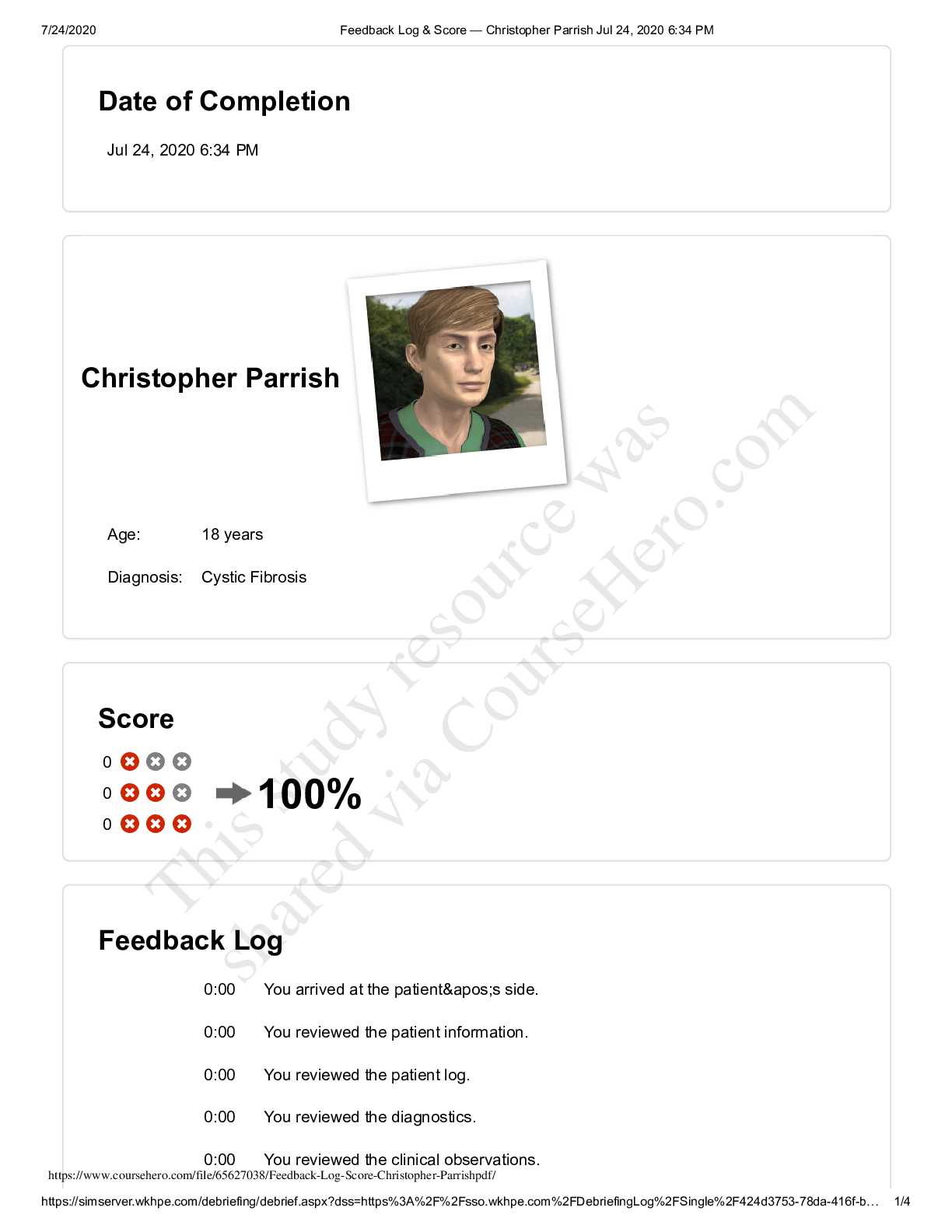
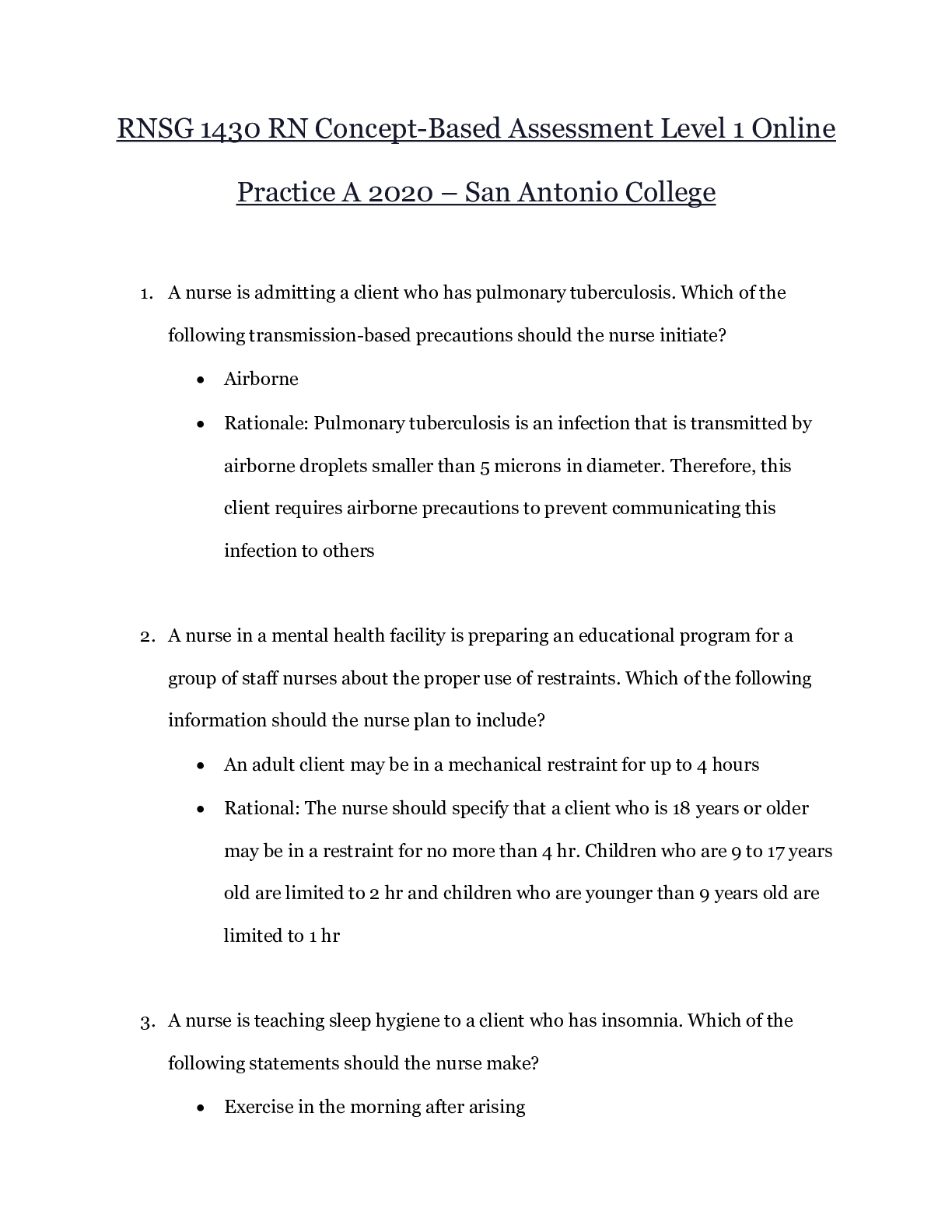


 – CHAMBERLAIN COLLEGE OF NURSING.png)
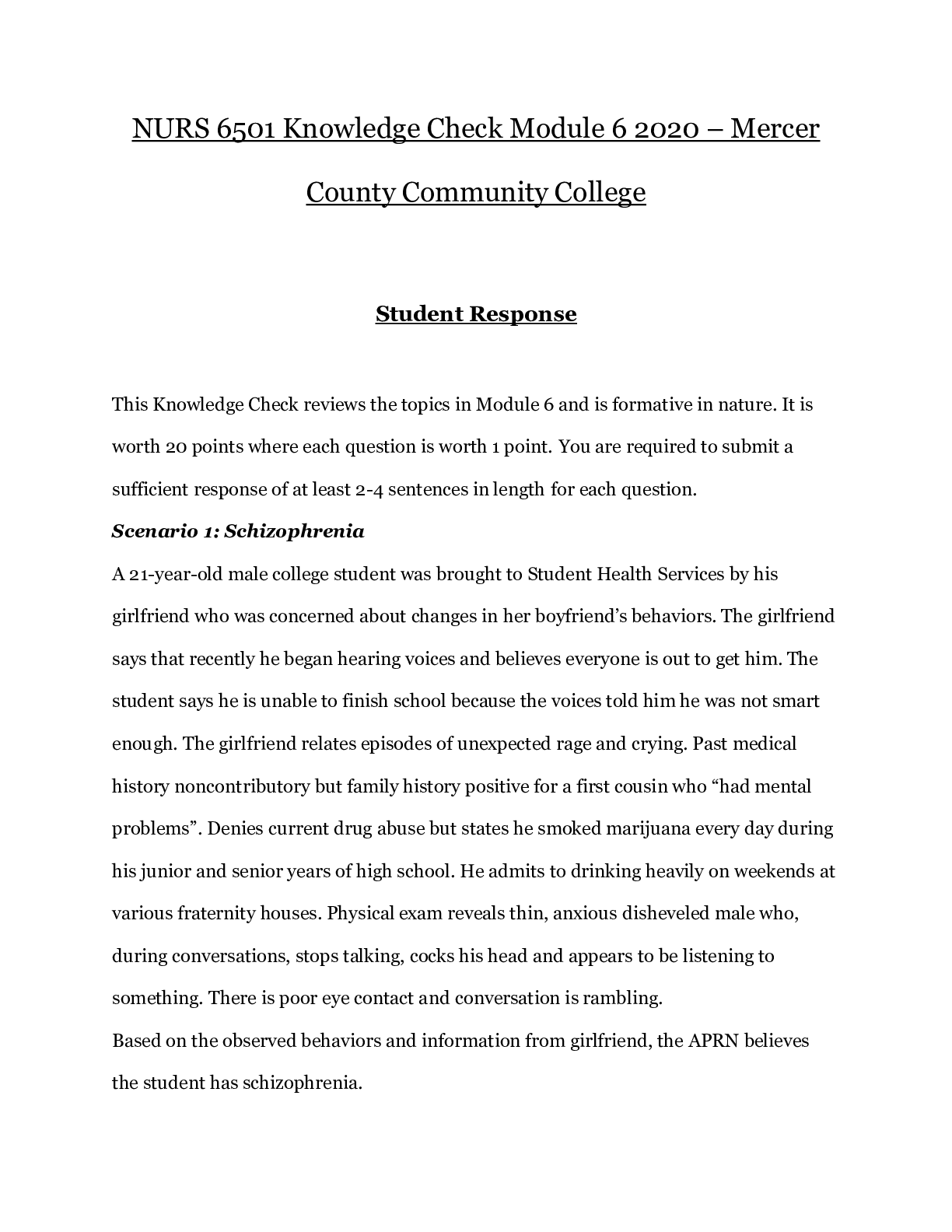
.png)
